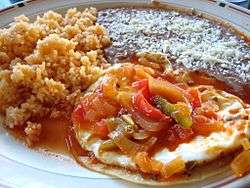Jumiles
'Col ![]() xu'miles are small stink bugs usually of the species Atizies taxcoensis native to the Taxco region of the state of Guerrero in Mexico. Any edible Hemiptera from the Coreidae or Pentatomidae families may be considered jumiles as well.[1] Their diet includes the leaves of the encina (Quercus ilex) tree.[2]
xu'miles are small stink bugs usually of the species Atizies taxcoensis native to the Taxco region of the state of Guerrero in Mexico. Any edible Hemiptera from the Coreidae or Pentatomidae families may be considered jumiles as well.[1] Their diet includes the leaves of the encina (Quercus ilex) tree.[2]
Jumiles are collected for their culinary value and may be roasted, fried, ground, or eaten raw. A salsa is prepared by combining fresh tomatoes, chiles and onions with jumiles that have been mashed in a molcajete. The salsa is served with corn tortillas.[2] The beginning of the jumil season on November 1 is the occasion of a large fiesta in Taxco. Fiesta-goers gather in the mountain park of Huisteco to collect jumiles and to crown a Jumil Queen. Jumiles are plentiful from November until February and become scarce after the first rains.[1]
Jumiles have a cinnamon-like odor. They are considered an acquired taste due to their high iodine content, which imparts a bitter, medicinal flavor.[3] Jumiles are also a good source of tryptophan and the vitamins riboflavin and niacin.[4][5]
Chumiles are a smaller, similar hemipteran of the same region (southern Morelos and northern Guerrero) which is used for food as well. Both jumiles and chumiles are insects of the order Hemiptera and family Pentatomidae. Pentatomids are commonly called "stink bugs" in English.
In the Globe Trekker TV travelogue episode "Ultimate Mexico", Justine Shapiro is shown eating a live jumil. Andrew Zimmern can also be seen eating jumiles on his television show Bizarre Foods, where he claims they taste just like tutti-frutti chewing gum.
See also
References
- 1 2 De Foliart, Gene. "3. The Use of Insects as Food in Mexico". The Human Use of Insects as a Food Resource. Archived from the original on September 26, 2012.
- 1 2 Hosking, Richard, ed. (2006). Wild Food: Proceedings of the Oxford Symposium on Food and Cookery, 2004. Totnes: Prospect Books. p. 180. ISBN 978-1-903018-43-9.
- ↑ Menzel, Peter (November–December 1999). "Why I Eat Bugs". Utne Reader.
- ↑ DeFoliart, Gene (1992). "Insects as Human Food". Crop Protection. 11: 395–399. doi:10.1016/0261-2194(92)90020-6.
- ↑ Massieu, H. G.; Trigo, M; Cravioto, R.O. and Calvo de la T., J. (1950). "Sobre la applicación del Metodo de Thomas a la dosificación de tirosina en algunos alimentos Mexicanos". Ciencia e Investigación (in Spanish). Argentina. 6: 424–428.
Further reading
Bukkens, Sandra G.F. (1997). "The nutritional value of edible insects". Ecology of Food and Nutrition. 36 (2-4): 287–319. doi:10.1080/03670244.1997.9991521.
External links
- Video of Mexican Celebrity Edgarito eating a live Jumil
- Story and photos of jumiles and salsa made from jumiles
